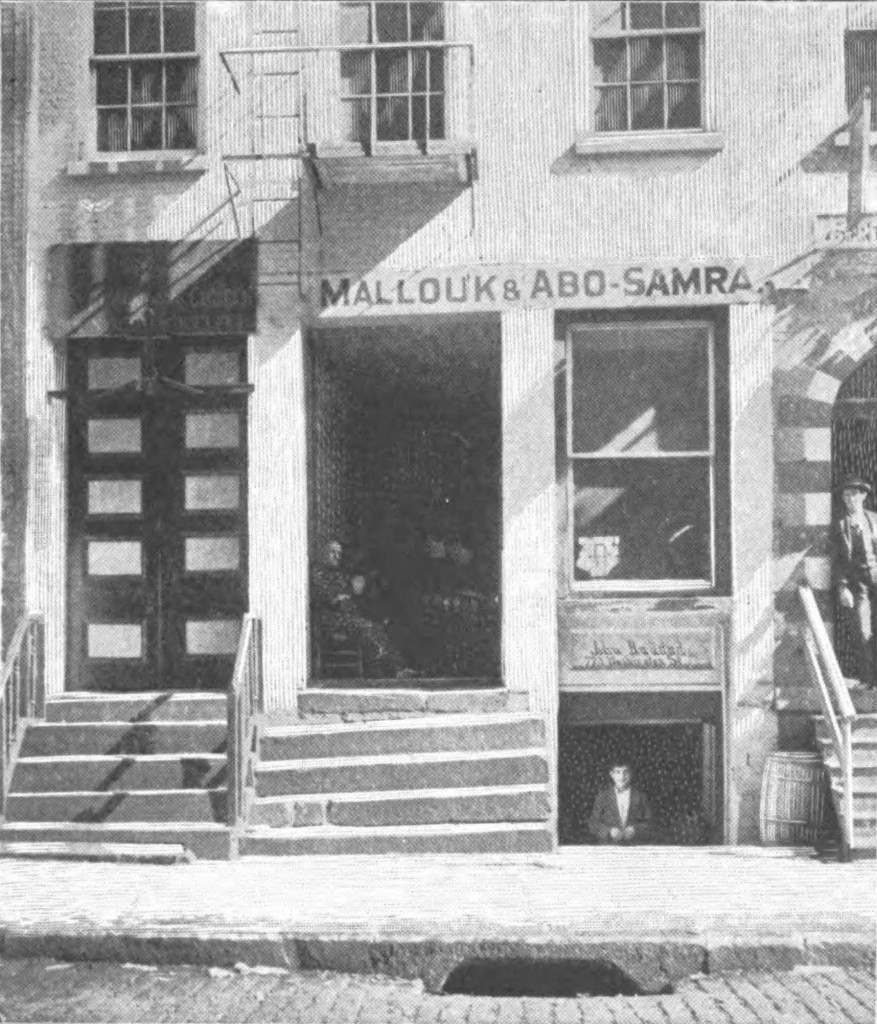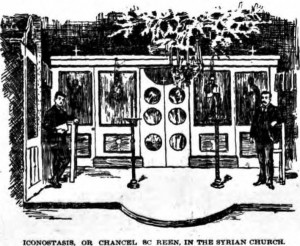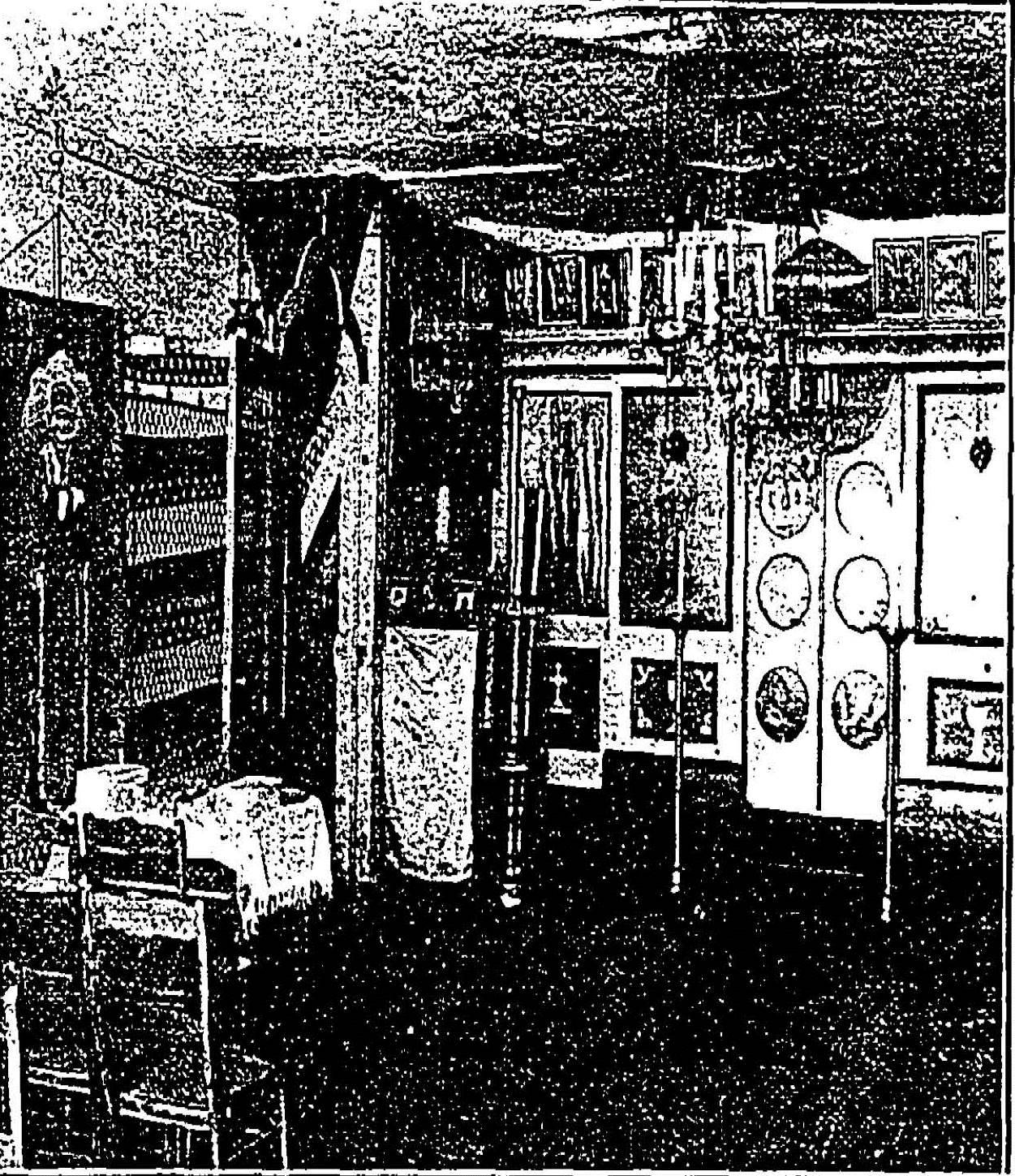St Raphael Hawaweeny arrived in New York City in 1895, and he immediately established a chapel for his growing community of Arab Orthodox Christians. The chapel was located at 77 Washington Street in Manhattan, right next to the Syrian Maronites’ own chapel. The Orthodox chapel, called St Nicholas, was a very modest affair, a low-ceilinged, second-storey room above a shop. But this unassuming place is the mother church for the entire Antiochian Archdiocese of North America.
Recently, when preparing for a series of talks for the clergy brotherhood of the Antiochian Diocese of Wichita and Mid-America, I discovered three heretofore unknown images of that original Antiochian chapel. I also found a great description from a contemporary newspaper. Here, have a look:

Exterior of 77 Washington Street, Manhattan. St Raphael’s chapel was on the second floor. From Frank Moss’ book The American Metropolis (1897).

Interior of St Raphael’s chapel shortly after its establishment. From the New York Press (1/26/1896).
Here’s how the New York Tribune described the chapel in an article published March 13, 1898:
The place of worship of the Greek Orthodox Syrians is over a store, No. 77 Washington-st. A steep stairway leads to the room which corresponds in size with the store below and is divided into two parts, the larger part being the auditorium and the small part at the rear being reserved for the priest and his assistants. The partition separating the sanctum from the maleroom is hung with pictures of the saints, and on either side of the altar are large embroidered pictures, also of saints, which were sent to the church from Syria.
Aside from these the chief decorations are three crystal chandeliers which hang from the low ceiling. Only one-half of the room is furnished with chairs. In explanation of this the priest said that only the women are permitted to sit in the house of God, the men remain standing during service. An air of neatness and cleanliness pervades the place, which is not in keeping with the Oriental decorations, and those who visit the place seem devout and earnest.
In 1902, St Raphael acquired a former Swedish Lutheran church on Pacific Street in Brooklyn and established St Nicholas Cathedral, which has since moved but remains the primatial see of the Antiochian Metropolitan in America.
But all that began with this little chapel, which really is not so different from so many dozens of storefront mission churches today.

I just came across a newspaper article on the chapel’s consecration:
https://books.google.com/books?id=f9ghAQAAMAAJ&pg=PA863&lpg=PA863&dq=77+Washington+Street+Greek&source=bl&ots=nlKqc4efZX&sig=a1v8k4Xp6On2Rf0TN140mQpxcAk&hl=en&sa=X&ved=0ahUKEwi_0PHT1svJAhXsoIMKHX-1DREQ6AEINTAD#v=onepage&q=77%20Washington%20Street%20Greek&f=false
New Outlook, Volume 52 November 23, 1895
Dedication of a Syrian Orthodox Greek Church
At 77 Washington Street, New York, on Sunday evening, November 17, the first Syrian Orthodox Greek church in this country was dedicated by Bishop Nicholas, Bishop of the Aleutian Islands, and chief of the Orthodox Greek hierarchy in America, with the solemn and stately ceremonies of the Orthodox Greek Church. Bishop Nicholas was assisted in the ceremonies by Archimandrite Raphael, besides five other Archimandrites and ten Syrian singers. Archimandrite Raphael was for some time President of a prominent college at Gazan [sic, “Kazan”] in Russia, but in accordance with a special request sent to the Holy Synod by the Syrian Benevolent Orthodox Society of New York, of which Dr. A. J. Arbeely is President, he was delegated as priest and missionary to the Syrians living in the United States, of whom there are 175,000, and 5,000 of whom are in New York.
The temporary altar at the rear end of the room was brilliantly illuminated with many candles. Gathered around it were the priests, in the midst of whom stood the Bishop, in a blue silk robe, which fell from his shoulders to the floor, and was fastened about his neck and shoulders with a heavy golden stole. On his head he wore a magnificent miter made of gold, which, flashing in the candle-light, reflected the gleam and glitter of rubies, sapphires.diamonds, and emeralds. The miter alone is said to be worth $15,000. Just behind the Bishop stood his two servants in Greek costumes, with yataghans and cimeters, looking more in keeping with a military camp than a religious ceremony. The service opened with a prayer, partly spoken and partly chanted by the Bishop, the Archimandrites, and the choir. The Bishop delivered an address in the Russian tongue, which was translated into the Arabic, in which he advised the Syrians to be good American citizens, to aid the poor, and above all to be faithful to the Church, assuring them of the entire sympathy of the Czar, of M. Pobledonotzow, Procurator-General of the Holy Synod, besides that of the 120,000,000 fellow-believers in the Czar’s dominions. He also said these dignitaries had lent aid both financial and moral to the establishment of this church. Then the water in the silver fount was blessed, incense was burned, and many invocations were made to prepare for the consecration of the building. This done, the Bishop with an olive branch sprinkled the altar and walls of the room with holy water, and pronounced the ceremony ended. After ordaining a number of deacons, and presenting each person present with a gilt cross which had lain for a long time on the Holy Sepulcher at Jerusalem, and had received the Bishop’s blessing, the Bishop and his assistants went to an upper room, where an Oriental dinner was awaiting them, when many congratulatory speeches were made in the midst of great rejoicing. Bishop Nicholas goes to the West and will dedicate Orthodox Greek churches at Scranton, Pa., Syracuse and Buffalo, N. Y., and Chicago, on his way.